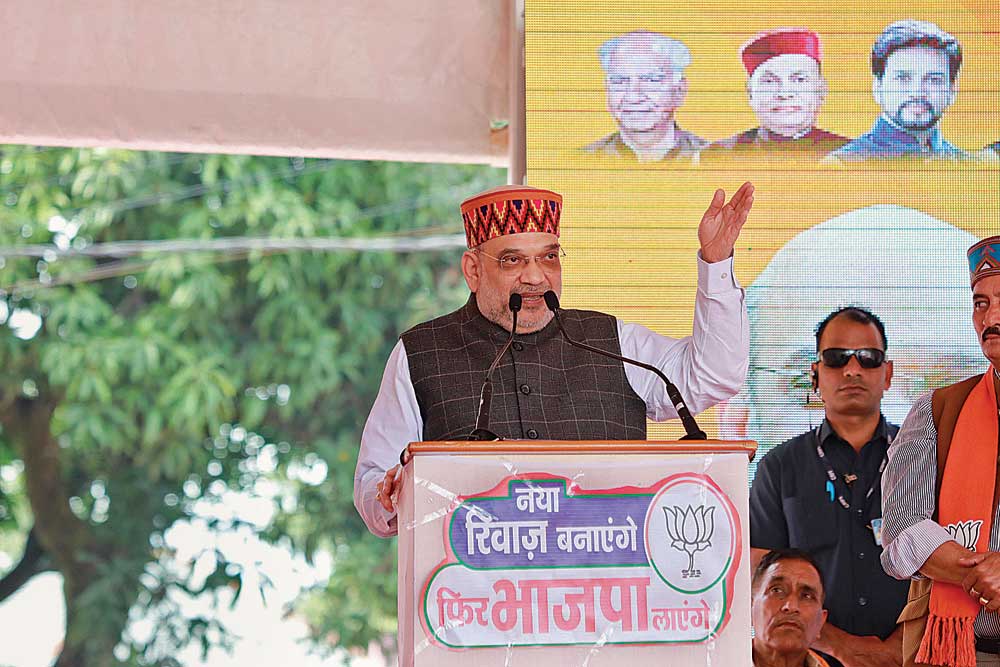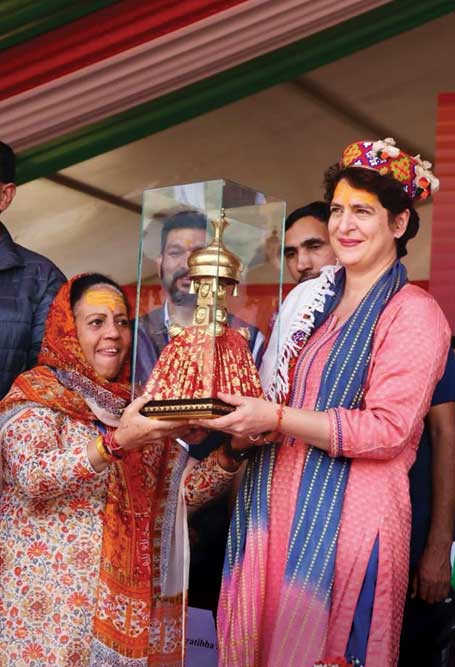Where Continuity is Change
In a break with tradition, incumbent BJP is confident of retaining power in Himachal Pradesh
 Siddharth Singh
Siddharth Singh
 Siddharth Singh
Siddharth Singh
 |
04 Nov, 2022
|
04 Nov, 2022
/wp-content/uploads/2022/11/Continuity1.jpg)
Himachal Pradesh Chief Minister Jai Ram Thakur at a rally in Mandi district on October 31, 2022
Sometime in late September, just about the time when the election campaign was heating up in Himachal Pradesh, a Congress organiser in Kangra town could be heard grumbling on the phone. He was upset that a truck containing publicity material—posters, leaflets, flags and more—had arrived at the party office but there was no space to store the stuff. If that were not enough, the local units of the party had made no arrangements to pick up the things and take them to different constituencies.
Kangra accounts for 15 constituencies in the 68-member Himachal Pradesh Assembly. Except for a handful of seats it is also a swing region like many other parts of the state. The swinging fortunes of parties often impart a peculiar blend to the politics of the state. Very often, elections are ‘issueless’; unless, of course, a party manages to upset some key constituents, such as government employees. This time, however, the contest is different from earlier occasions. The Bharatiya Janata Party (BJP), even as the incumbent, is displaying a degree of confidence that is unusual.
Some of it has to do with the slew of projects and welfare measures launched in the last five years. But that does not explain what is going on. Take the issue of bringing back the Old Pension Scheme (OPS), something that could have landed BJP in a pickle given the demand’s populist flavour. But so far, just a week before polling, the party has managed to parry this challenge with aplomb. It is just one indicator of changing political equations in the state.
It is a populist issue that all parties have latched on to in this election season. Most have promised to restore OPS that was abandoned in favour of a “pay-as-you-go” system in 2004. The Congress government in Rajasthan recently restored the old scheme. On October 21, Delhi’s chief minister and the convenor of the Aam Aadmi Party (AAP), Arvind Kejriwal, said, “If the people of Himachal Pradesh and Gujarat give [us] a chance, we will implement OPS there too.”
With AAP’s campaign stopping in its tracks, Himachal has returned to its two-pole politics. But something has changed. Since the 1980s, no winning party has returned to power in the next election. But this time, a confident BJP has coined the slogan ‘naya riwaz banayenge, phir BJP layenge’
This climate of populism has had an effect in Himachal as well. BJP has handled the issue tactfully. While addressing gatherings on October 30 in Chamba district, Chief Minister Jai Ram Thakur said that only BJP was capable of implementing OPS. Congress, he said, was misleading people on the issue. He also said that wherever Congress is in power, it has not implemented the scheme. The same message was conveyed on October 30 by a former prabhari of the state, Mangal Pandey, in Mandi where he said a committee had been formed to look into the issue and its decision was expected soon. Neither leader made any outright promise of restoring OPS.
The same message was repeated by Union Minister Jitendra Singh in Shimla two days later on November 1. He said that only Prime Minister Narendra Modi and Chief Minister Thakur could find a solution to the OPS issue. Criticising Congress, he said that if it were serious, a solution could have been found during the tenure of the late Virbhadra Singh as chief minister. Instead, Congress is now misleading people on the issue. Just like Thakur and other leaders, Singh’s language on the subject was careful.
In Himachal Pradesh, this is a live-wire issue and a major expense for the state government. In 2022-23, the state government’s committed expenditure will eat up 77 per cent of its revenue receipts. Of this expenditure, 21 per cent is accounted for by pensions and another 42 per cent by salaries. The political caution in veering away from any commitment on this score is understandable.

In Chamba and elsewhere on October 30, however, this was just one issue, one that was successfully parried. BJP’s brass unleashed a blitzkrieg of sorts on that day in all constituencies of the state. Top leaders of the party, from its central leadership to those from other states like Yogi Adityanath, have been pressed into the campaign.
The momentum is set to continue in the days ahead. On November 5, Prime Minister Modi is expected to address rallies in Sundernagar and Solan and on November 9 he will be back in Kangra and Hamirpur districts. Union Home Minister Amit Shah is already on an electioneering tour of the state. Defence Minister Rajnath Singh and the Union minister for road transport and highways, Nitin Gadkari, too, have been pressed into the campaign.
BJP is displaying a confidence that is unusual. Some of it has to do with projects and welfare measures launched in the last five years. But that does not explain what is going on. Take the issue of bringing back the old pension scheme that could have landed BJP in a pickle. But the party has managed to parry this challenge with aplomb
THE CONTRAST WITH the Congress and AAP campaigns is stark. For Congress, the party’s general secretary, Priyanka Gandhi, addressed a rally in Mandi on October 31. Chhattisgarh Chief Minister Bhupesh Baghel has also been sent to the state for the election. Congress, however, is largely reliant on its local leadership to spearhead the campaign as the party’s top leaders are involved with Rahul Gandhi’s Bharat Jodo Yatra. That tour is at the moment somewhere in Telangana. Ironically, the Yatra will skip election-bound Himachal and Gujarat.
The result is that the weight of the campaign has fallen on the shoulders of state leaders like Pratibha Singh, Virbhadra Singh’s widow. Congress leaders are loath to openly admit that Singh’s loss is pinching them but the reality is that his legendary political skill in keeping the party’s warring factions in line are sorely missed. Both BJP and Congress workers say that had Singh been around, the contest would have been very different.
The other party in Himachal’s electoral equation, one that was expected to make a dent this time, AAP, has literally disappeared from the state. The last time a leader from AAP’s senior team—Kejriwal and Manish Sisodia among others—visited Himachal was sometime in July. After a promising start, rallies in Kangra, Hamirpur and Mandi—three important political locations—these leaders did not devote any time or attention to furthering their political goals in the state. To add to the problem, leaders from Punjab, where the party is in power too, have not devoted any time or effort in Himachal Pradesh. Instead, Punjab Chief Minister Bhagwant Mann is often seen in Kejriwal’s company in faraway Gujarat.
What probably stopped AAP in its tracks was the detention of Delhi AAP leader Satyendar Jain who had been tasked with building the party organisation in Himachal. Jain, currently in jail in Delhi, could not impart sufficient momentum to the party before the election. The result is that while AAP has announced candidates for the election of November 12, its prospects remain dim.

The result is that Himachal Pradesh has returned to its two-pole politics. But something seems to have changed. Unlike in the past, when a party’s reverse count in government began as soon as its ministers took oath, this time the situation seems different. Since the 1980s, no winning party has returned to power in the next election. But this time, a confident BJP has coined the slogan “Naya riwaz banayenge, phir BJP layenge (We will change the tradition and bring back BJP again)”. Congress, too, has its variant on the theme. At her rally in Mandi on October 31, Priyanka Gandhi said that “paanch sal hum, paanch sal woh” (five years us and five years them) is a great tradition created by the people of Himachal Pradesh. These are just slogans but they represent a changed reality. The incumbent is behaving like a challenger while the challenger is diffident.
IN THE MIDST OF what is otherwise a low-key election, the one constant of Himachal politics remains unchanged: rebellion by dejected candidates. The phenomenon can be observed in every state but its intensity in Himachal is of a different order. Even an organisationally driven party like BJP is not immune to it.
In recent days, there have been scores of expulsions from both Congress and BJP. BJP has expelled Kishori Lal, its MLA from Anni constituency in Kullu district. Along with Lal, the party also expelled three former MLAs and one former Rajya Sabha MP for contesting against its official candidates. But even after this drastic step there are about 17 rebels standing against official candidates. Something similar is happening in the Congress camp. The party expelled its district chief from Kullu, Budhi Singh Thakur. Congress has carried out its own expulsions. The party has expelled its seven-time veteran MLA, Gangu Ram Musafir, who contests from Pachhad constituency in Sirmour district. This time, Musafir is contesting as an independent. The party has also expelled five other rebels.
Priyanka Gandhi addressed a rally in Mandi on October 31. Congress, however, is largely reliant on its local leadership to spearhead the campaign as the party’s top leaders are involved with Rahul Gandhi’s Bharat jodo yatra. Both BJP and Congress workers say that had Virbhadra Singh been around, the contest would have been very different
Rebellion in both parties is not geographically limited to some regions but is an across-the-state phenomenon. But unlike other Assemblies with a small number of seats, Himachal Pradesh has not seen rebels turn into kingmakers as its voters always deliver a decisive mandate for one party. But the trend has persisted for a very long time.
Yet there are constituencies where both BJP and Congress are in trouble. In Anni, for example, both parties are facing rebellion. Similarly, in Bilaspur Sadar, BJP’s official candidate—Trilok Jamwal—is facing heat from the rebel Subhash Thakur. For Congress, the official candidate is Bumber Thakur. The party managed to make the rebel Tilakraj stand down but neither is he seen supporting the official candidate nor is he openly against him. The result is that the party fears ‘internal sabotage’ from the candidate who has stood down.
Populism, rebellion and the tendency to throw out incumbents are some of the perennial features of Himachal Pradesh’s political landscape. But this time round, a different air pervades the hill state. What’s afoot?

/wp-content/uploads/2025/07/Cover-Shubman-Gill-1.jpg)












More Columns
‘Fuel to Air India plane was cut off before crash’ Open
Shubhanshu Shukla Return Date Set For July 14 Open
Rhythm Streets Aditya Mani Jha